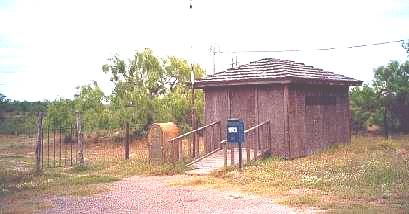

Kenedy County
Towns

Armstrong

Armstrong Post Office
Major James B. Durst purchased the Armstrong Ranch land in 1853. His daughter married the Texas Ranger Capt. John B. Armstrong in 1878, and they moved their family to the property in 1882. Their descendants continue to run the ranch today.
The highest population occurred in 1929 at 25 persons, although when a bus from the Rio Grange Valley occasionally breaks down near Armstrong the population temporarily swells to 40 or more. Amenities are few and it's hard to see where Armstrong's 20 estimated residents actually live.
In 1904 the St. Louis, Brownsville and Mexico Railroad came through and added the ranch to its stops. The railroad sold out to the larger Missouri Pacific. The first post office operated under the name of Katherine, but was renamed in 1915. Highway 77 was completed through the ranch in 1940.
- Tobin Armstrong, Armstrong Ranch, Armstrong, TX, April 23, 2002

NORIAS
Norias is on the Missouri Pacific Railroad and U.S. Highway 77 thirty-two miles south of Sarita in southwestern Kenedy County. Noria is a Spanish word for "well." The St. Louis, Brownsville and Mexico Railway was completed into the area in 1904. Norias was owned and operated by the King Ranch as a shipping point and division headquarters. In 1948 the settlement had a railroad station, a school, and an airway beacon. In 1982 it had several farm units, a cemetery, and a few dwellings. It was a dispersed community in the early 1990s.
T. C. Richardson
| Norias Ranch Raid
The number of raiders was variously reported as anywhere from fifty to seventy men. Ranchhands Pedro Longorio, Luis Solis, and Macario Longorio said later that around two A.M. at the King Ranch Cerritos headquarters, fifty-two outlaws forced them to water and feed their horses. They reported that Antonio Roche and Dario Morada led the group. Another report said that Luis de la Rosaqv commanded a force of about fifteen men and had joined with a band of twenty-five. The raiders forced Manuel Rincones, a King Ranch employee, to guide them. At nightfall, after two hours of fighting, the raiders suddenly stopped firing and vanished into the darkness. They had broken into the section house and killed Manuela Flores. George Forbes, Frank Martin, and two soldiers were wounded. Some five or more raiders were killed and perhaps a dozen wounded. A wounded bandit said later that they expected to find only three or four cowboys at the headquarters. They planned to rob the ranch store, derail and loot the night train, and burn the ranch house. The Norias raid provoked outrage in the lower Rio Grande Valley.qv Mexican banditry escalated, and the United States Army promptly increased its presence in the area to curb the violence. |

Rudolph
Rudolph, a shipping point on U.S. Highway 77 and the Missouri Pacific line, thirty-eight miles south of Sarita in southwestern Kenedy County, was named for Rudolph Kleberg, United States congressman around 1900. The St. Louis, Brownsville and Mexico Railway was completed through the area in 1904. That year a post office opened, but it closed in 1907. In 1948 the site had a railroad station and an airway beacon light. In 1982 a pump house was still in operation.

Sarita
Sarita, the county seat of Kenedy County, is an incorporated town off U.S. Highway 77 twenty miles south of Kingsville in extreme northwestern Kenedy County. The land for the townsite was part of the Kenedy Ranch owned by John G. Kenedy, who named the new community after his daughter Sarita. The town was established in 1904 and served as a ranching center for the Kenedy Ranch and Kenedy Pasture Company. Sarita was a stop on the St. Louis, Brownsville, and Mexico Railway that was chartered in 1903. The townsite was moved a mile east in February 1905, when a stretch of the railroad was relaid, but Sarita was not actually surveyed and platted until 1907. Land companies out of St. Louis, Kansas City, and Chicago promoted Sarita to northerners and ran homeseeker trains taking prospective buyers to South Texas. Upon arrival, visitors toured the area in jolt wagons while a seller made his sales pitch; buyers purchased lots from the Kenedy Town and Improvement Company. Early settlers included the Turcottes, Braunes, Pfaus, Johnsons, and McLeroys. There has been a post office in Sarita since 1904. By 1907 there was a lumberyard, a cotton gin, a one-room school, a nursery, and a railroad depot. Since Sarita was a section point for the St. Louis, Brownsville and Mexico Railway, there was a section house and water tank for the trains. Two artesian wells provided water to Sarita before another water tank was built, and the town had two stores: the Pfau store and the company store (and post office). A phone line ran from the company store to Rancho La Parra, the Kenedy Ranch headquarters, six miles east. Sarita was centered on a farming and ranching economy, supported by a population of Anglos and Hispanics. Many settlers worked for the Kenedy Ranch, while others purchased or leased pasture from the Kenedy Pasture Company to raise cotton.
Sarita, originally in Cameron County, became the county seat of Willacy County when that county was formed in 1911. The Pfau store was purchased by John G. Kenedy and later served as the first courthouse until it burned down sometime before 1921. The town population was about 300 before 1916, when a severe hurricane hit. Subsequently many homesteaders moved away, and much of the land reverted to the Kenedy Pasture Company. In 1921 Sarita became the seat of government for the new Kenedy County. In 1936 the community population was 200, and in 1940 the Nueces Electric Cooperative supplied it with electric power. By the 1940s U.S. Highway 77 went through Sarita to Brownsville, though for a time before land right-of-ways were granted, the highway ended at Sarita with a barbed-wireqv fence barrier. The population of Sarita remained at 200 in 1950, and during the 1980s the population remained at a steady 185. The town still served as an oil and ranching center. After the death of Sarita Kenedy Eastqv in 1961, Rancho La Parra was given to the Oblate Fathers of the Catholic Church and served as a prayer house. In the late 1980s Sarita included ranch offices, a commissary and post office, a Catholic church, a school, a courthouse, and several homes and ranch buildings. Its population was still reported as 185 at that time.

Turcotte
Turcotte, on U.S. Highway 77 and the Missouri Pacific line, sixteen miles south of Sarite in southwestern Kenedy County, was named for Marie Stella Turcotte Kenedy, wife of John G. Kenedy, Sr. and mother Sarita Kenedy East. In 1904 the St. Louis, Brownsville and Mexico built to the site, and by 1948 the community railroad station and an intermediate-level airfield. Turcotte was the site of a radio tower in 1979 and in the early 1990's remained a shipping point.